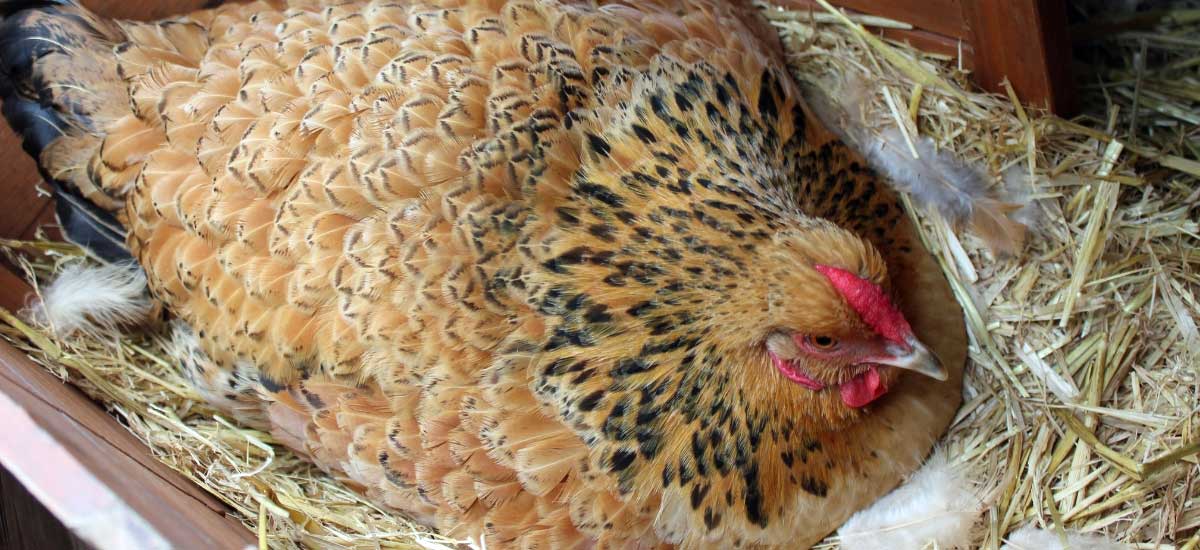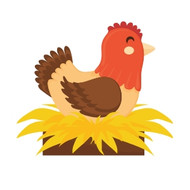Broody Chicken - What to do
A broody chicken is not merely laying in the shade on a warm summer English day. Nor is it having a siesta while the rest of the flock is actively enjoying the run. What is a Broody Hen? What are the symptoms and what can be done to help?
If you have noticed one or more of the hens seem to be disappearing, sitting on a nest, or your egg production is dwindling, or perhaps the chicken races its feed down in a minute then runs off in a frenzy, your chicken is likely broody. This type of starving chicken routine is a classic symptom of a broody chicken racing to get back on the nest.
What is a Broody Hen - Signs:
The cause of Broodiness in chickens is varied. Warm weather in the United Kingdom can contribute to the chooks going crazy. All of a sudden all the locals have broody hens. Once one hen starts sitting on eggs, it seems like they all want to. So what can you do to help correct this behaviour?
The first signs of broodiness are a drop in the number of eggs produced. This does not mean they are not laying. It just means they are no longer laying in their nesting box. For no apparent reason, the hens now prefer somewhere more secluded to nest. This nest may lie behind a shrub, under a bush or a private clump of grass. You might also look behind the chook pen as well as under it if height allows them access. Interestingly, if one hen decides they’ve found a right spot to lay an egg, soon they all want in on the change of scenery.
Other signs of a Broody Chicken include spending an extended amount of time in the nesting boxes, building nests in dark, private spots. A sure sign is if the chooks start spending the night in their nest, wherever it is, rather than roosting with the rest of the flock. Ignoring the behaviour will not change it. Intervention is the only way.
Broodiness is not linked to a particular breed more than another. However, most white egg breeds seldom go broody. Broodiness does have a link especially for backyard chicken keepers who keep larger, heavier breeds of chickens for their brown eggs. In the United Kingdom, there are a number of backyard chicken keepers with larger breeds due to our cold winter climate. If you know someone with larger hens, share this story with them on Facebook or Instagram, they most likely will thank you for the helpful advice. The three main reasons for broodiness in poultry are the environment, the chicken itself and also the chicken's hormones.
Why is broody a problem?
If you want the addition of chicks, then Broody hens are great news. Our customer chose to let her leghorn sit. There are however negatives of having Broody Chooks:
- Brood behaviour in the coop decreases egg production
- Broody chooks cease laying, and broodiness is contagious. So once one hen is broody others may start sitting also.
- Also, broody hens may steal other hen’s eggs to sit on. They may even scare other hens out of the nest box, forcing them to lay elsewhere.
- Some broody chickens will sit on eggs forever, even if they aren’t fertile.
- Broody hens are compromising their health
I’ve even read about hens sitting on golf balls as well as rocks. It takes twenty-one days to hatch a chicken egg. Despite this, a broody hen will not stop sitting even on day twenty-two. The chicken fails to notice the egg is not fertile and interestingly keep sitting.
Extended time on the nest means broody hens are not eating or drinking adequately. They are also avoiding dust bathing as well as generally taking care of themselves. They are sacrificing their health for the needs of their eggs. So if you do not want chick hatching, it is better not to allow hens to sit for extended periods. Some hens are so broody they choose not to eat for a day causing them to lose their condition quickly.
Not all chickens make good mothers so just because a chicken seems determined to be broody does not mean that it will see it through. Some abandon the nest before the 21 days are up. Some may harm their chicks although this is usually unintentionally. If you are going to let a hen sit, choose the bird carefully. If you choose poorly, you can end up with a lot of work on your hands.
What to do when hens go broody
If you want to expand your flock with some chicks, having a broody hen is excellent news.
However, if you don't wish to have chicks you shall need to 'break' your broody hen, this means to stop her being broody as soon as possible. But if not, it is best to “break” your broody hen. The mission should you choose to accept it is to stop her from being broody, as soon as possible.
How to stop a broody hen
The less time a hen has spent sitting, the easier it is to convince her to give up the nest and return to normal flock life. It is better for the chicken’s health, prevents the broodiness spreading, and also means egg production generally returns to normal. Breaking broody hens - it's not as brutal as it sounds
There are loads of ways to break a broody hen, and everybody has a favourite. The first step in any method, of course, is to take away the eggs! The favourite way of most chicken keepers that I know is the BBB - the broody-breaking box.
The boomerang method
- Remove the hen from the nest multiple times daily. This technique is highly effective in the early stages.
- Use bribes or treats such as dried mealworms to help keep the chicken of the nest.
- You can also move the hen out of the nesting box and onto the roosts at night. Usually once moved they are too timid to make their way back in the dark.
The lock-out method
- In the morning after eggs are laid, lock the hens out of the coop for the day. Make sure they have adequate food, water, shade as well as protection from predators.
- Blocking off the nesting boxes for the day is also useful. However, a super-determined hen will build sneaky nests in the run as well, just as the customer's Leghorn did
The cool-down
Cooling a hen's body temperature can help convince them they are not broody, as the heat is essential for the eggs. There are many ways to do this, some kinder than others. Some people bathe their birds in cool water on a warm day. Others suggest placing ice cubes or frozen water bottles in the nest.
Chicken Boot camp
Increasing a bird's activity also help decrease the hormones that make them broody. The lock-out method relies on this. You can also use the boomerang method but take the hen as far as possible from the coop so there is lots of activity as well as distractions before they get back to their nest.
The BBB - broody-breaking box
Probably the kindest as well as the most reliable method of breaking a broody hen. The idea relies on placing the hen somewhere that they can’t nest. You could use hospital pens or a bird cages. The containment box should be raised and have a wire floor so that air can pass underneath and cool the hen. Ensure the wire floor is thick enough that it doesn’t damage the hen’s feet. There should be no nesting material as well as no dark corners. Provide food and also ensure adequate water. Even add a roost if you like. After a couple of days, let the hen out. They should re-join the flock, but if they’ve been broody for a while or have extra strong instincts, they may go back to the nest, in which case leave them in the box for a bit longer.
If you have a topic you would like us to write about, send us your ideas through the contact us page of our website.



